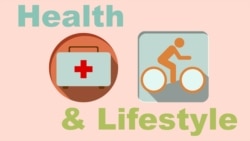From VOA Learning English, this is the Health & Lifestyle Report.
For millions of people around the world, the coronavirus pandemic has changed many daytime activities. For some, it also has affected their sleep.
Fears of loss, isolation and sadness come out during sleep. Many say they awake feeling even more pressured and fearful.
Experts say some pandemic dreams are about the fear of the unknown: Who is a threat? When will the pandemic end? Some dreams are about fearing for the safety of loved ones. And other dreams are about the loss of normal life.
Mary Alice Mathison is a clergyperson in Florida. She dreamed 500 people showed up for a funeral at her church and would not go home.
Ashley Trevino is out of work in Texas because of the pandemic. After the first COVID death in her area, she dreamed that she and her girlfriend were injected with the coronavirus by government workers.
In Pakistan, Roha Rafiq dreamed that she was one of only 100 people left on the planet not infected with COVID-19. The college professor said that in her dream infected people were chasing her and the other uninfected people. They wanted to make the world the same for everyone.
“I think,” Rafiq later wrote on Twitter, “this anxiety has given me this dream.”
She is not alone.
So many people are sharing their dreams that there is an online collection under the name “I Dream of COVID” on the social media website Twitter. Experts observe that in recorded history, humanity has rarely experienced “collective dreaming” on such a large scale in real time.
Harvard University professor Deirdre Barrett is studying COVID dreams worldwide. She has collected 6,000 dreams from about 2,400 people.
Barrett says the flu pandemic of 1918 is probably the “most comparable thing.” But, as far as she knows no one has examples of dreams from that pandemic.
Cathy Caruth is a professor at Cornell University. COVID-19 dreams, she says, are similar to the dreams of Hiroshima survivors who worried about nuclear radiation. They are also similar to nightmares described by soldiers from the Vietnam War.
Healthcare workers more at risk
Some dreams are about everyday activities we can no longer do – seeing friends, attending a party, or going to the movies. However, that changes greatly for health workers on the front lines of the pandemic.
Professor Barrett says she has found a common theme in their dreams. They are responsible for saving a person’s life. But they are failing, and the person is about to die.
When healthcare workers dream about their child or parent getting the virus, Barrett explains, it often does not stop there. The next step is finding out they gave the virus to their loved one.
Barrett says they are having “nightmares that reenact the things” they are experiencing.
Tips for getting better sleep
Dr. Lisa Medalie is a sleep expert at the University of Chicago. She advises that it is important for people to get good sleep during the pandemic. On the university’s website, she gives these suggestions.
Structure your daytime schedule.
Commit to daily activities. Exercise, eat and talk to family and friends at regular times. This will build structure to your days.
Get alone time each day.
Medalie suggests at least one hour of alone time each day. This may be hard. But she reminds us that spending time alone and doing something we enjoy is important.
Create a peaceful sleep environment
Make sure your bedroom environment is peaceful. Keep the room cool, dark, and quiet. Limit the amount of clutter and noise in your bedroom.
Create a sleep schedule and limit daytime sleep
Get the same amount of sleep each night. Most adults need seven to eight hours a night. And once you decide on your bedtime, stick to it. Also, daytime sleep should be less than 30 minutes and before 2 p.m.
Limit screen time at night
Turn off your electronic devices one hour before bedtime. Do not bring your devices into your bedroom. This way you will not look at COVID-19 updates during the night.
Try breathing exercises.
Use slow deep breaths to fall asleep or to return to sleep. Breathe in slowly through your nose for three seconds. Then breathe out slowly through your mouth for three seconds.
And that’s the Health & Lifestyle report.
I’m Anna Matteo.
Anna Matteo adapted this story for Learning English based on Associated Press news reports and the University of Chicago Medicine. Hai Do was the editor.
________________________________________________________________
Words in This Story
isolation – n. the state of being in a place or situation that is separate from others
anxiety – n. fear or nervousness about what might happen
scale – n. a distinctive relative size, extent, or degree
nightmare – n. a frightening dream that usually awakens the sleeper
theme – n. a particular subject or issue that is discussed often or repeatedly
clutter – n. a large amount of things that are not arranged in a neat or orderly way or a crowded or disordered collection of things
stick to it – phrasal verb to continue doing or using (something) especially when it is difficult to do so












